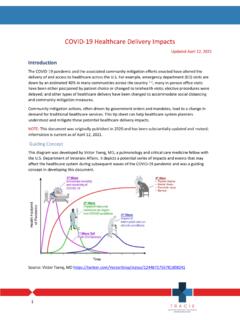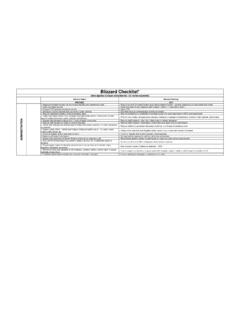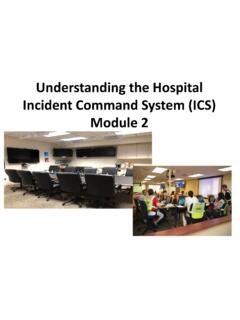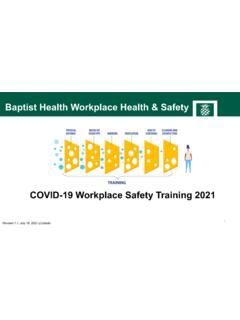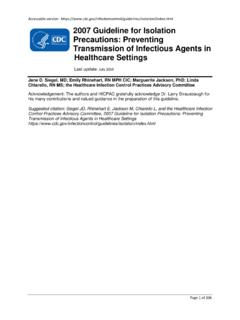Transcription of Acute Care Delivery at Home - United States Department of ...
1 TRACIE NEAUNCAH EM(flG(hC'f ,11(,AHONUS INFO MATION' GATEWAY Acute care Delivery at Home April 2021 Delivering hospital-level care in a patient s home has been a patient surge management strategy for some healthcare facilities in the and several other countries around the world for many years. This Acute care Delivery at home model can become part of a healthcare facility s strategy for a variety of reasons. Short-term implementations can be a valuable resource in response to a public health emergency to help alleviate patient surge in hospitals. For example, during infectious disease outbreaks, Acute care Delivery at home can allow high-risk patients to receive hospital-level care at home while reducing their potential exposure.)))
2 Acute care Delivery at home can also be a long-term strategy to allow patients more flexibility in where they receive their care , providing equivalent or superior care in the comfort of their homes. There are several factors to evaluate when contemplating the implementation of an Acute care Delivery at home program. This document recognizes the varying approaches to applying this model and that there is a wide spectrum of care , eligibility requirements, resource needs, and financial/ reimbursement/ payer models. The goal of this tip sheet is to provide a general overview of characteristics of various types of Acute care Delivery at home programs ( , Hospital at Home , virtual hospital at home, Acute care at home, home hospitalization, early supported discharge) to help healthcare providers better understand this care model. Some Acute care Delivery at home programs are fully integrated into care Delivery and have been part of business as usual for years.
3 While unique to each program, these implementations have developed a qualification process for patients, often including a list of inclusive diagnoses, and policies and procedures surrounding transitioning to and managing care at home. Other programs have been developed recently in response to COVID-19 to alleviate overcrowding in the hospital, treat milder cases of COVID-19, and isolate patients with comorbidities that place them at high-risk for a COVID-19 infection while still providing hospital-level care . Studies have identified many advantages of the Acute care Delivery at home model and shown condition-specific quality indicators can be met at the same rate or better, though there are individual variations between studies. In addition to the reduction in hospital inpatient census during a public health emergency, patients have demonstrated improved emotional state at home with family, friends, and pets as they Some programs have also realized reductions in: 1 If diagnosed with COVID-19 or another highly infectious disease, patients must be counseled on infection 1 prevention at home and avoidance of family and friends.
4 TRACIE NEAUNCAH EM(flG(hC'f ,11(,AHONUS INFO MATION' GATEWAY Inpatient-induced delirium (74% reduction) Pressure sores/ other complications from inactivity (as patients have improved mobility at home) ( 23% mobility as an inpatient vs. 12% at home) 30-day readmission rates (23% inpatient vs. 7% in Acute care Delivery at home program) Skilled nursing facility admissions and emergency Department (ED) visits Mortality Stress in patients and caregivers General Characteristics of an Acute care Delivery at Home Program Acute care Delivery at home allows for in-home, hospital quality medical care to be administered to interested patients with qualifying Acute conditions, instead of admission as an inpatient at a hospital.)))
5 Other characteristics of these programs include: Patients are assessed by a healthcare professional as they normally would be and may receive some treatment to stabilize their condition and determine eligibility to receive Acute care Delivery at home. Some programs allow patients to directly enter the Acute care Delivery at home program based on referral from a treating primary care physician (PCP) or specialist, depending on the participation requirements of the organization. Programs may also elect to perform emergency evaluations at home based on their capabilities and plans, so patients may not need to be assessed in a physical ED prior to admission. Once admitted, all patient transport needs will be provided by a hospital or contracted entity to the patient s home, where they will continue to receive hospital-level care . In the event that in-hospital diagnostics or short-term treatment is required, patients can be transported back to the hospital for those services, then transported back home through transportation coordinated by the hospital.
6 While this level of care may reduce readmission to the hospital and ED visits within the first 30 days, it is not intended to subvert hospital evaluation and stabilization or treatment that needs to be done in the healthcare facility. While Acute care Delivery at home is not post- Acute care , one of the main strengths of these programs is that they can negate the need for facility-based post- Acute care , such as skilled nursing facility placement, particularly in the 30-day post admission window. The model is intended to manage Acute conditions, not chronic case management, as the name implies. care can be implemented as a direct response to patient surge during a public health emergency. 2 What Acute care Delivery at home is NOT Home health Case management Chronic di sease management Skilled nursing Admission prevention TRACIE NEAUNCAH EM(flG(hC'f ,11(,AHONUS INFO MATION' GATEWAY o Patients with co-morbidities that put them at high risk for complications from an infectious disease may be managed in the home to reduce the risk of exposure.)))
7 O care may be delivered in a virtual environment under certain circumstances, reducing the likelihood of exposures to healthcare providers. o The use of limited personal protective equipment (PPE) may be reduced through the reduction of in-person contact in the virtual environment. o Patients receiving care within the Acute care Delivery at home model can alleviate the strain on the hospital census by allowing limited in-hospital care to be dedicated to the most staff-intensive treatment. General Features of Acute care Delivery at Home Programs2 Acuity and complexity of the patient condition differentiates Acute care Delivery at home from other community services (higher acuity patients). Ensures urgent access to hospital-based diagnostics, if required ( , endoscopy, radiology, cardiology). Provides access to hospital-level interventions at home ( , intravenous fluids, medication therapy, oxygen).
8 Requires daily input from a multidisciplinary team that includes multiple visits and provisions for 24-hour care coverage, with the ability to respond to urgent visits. Requires Acute care level specialist leadership, at least daily changes in the care plan, and clear lines of clinical responsibility. Employs staff that are experienced and comfortable treating patients in the home environment. Includes defined inclusion and exclusion criteria. Determines the appropriateness of the home environment based on characteristics such as climate control, running water, and social support. Evaluating Organizational Readiness Providing Acute care Delivery at home requires strategic cooperation across the organization in order to develop and implement the new policies and procedures necessary to provide this level of care . Organizational resistance to change is often cited as one of the biggest hurdles when developing and managing an Acute care Delivery at home program.
9 The following considerations can help build and maintain strategic support for an Acute care Delivery at home program:3 2 Titchener, Karen. (2020). Efficient, Effective, Excellent: Issues in Logistics and Operations in Hospital at Home: Slides and Recorded Webinar. 3 Titchener, Karen. (2021). Building Support for Your Hospital at Home Program: Issues in Strategic Engagement: Slides and Recorded Webinar. 3 TRACIE NEAUNCAH EM(flG(hC'f ,11(,AHONUS INFO MATION' GATEWAY Spotlight: Hospital at Home Hospital at Home is a specific model, first developed by Johns Hopkins Schools of Medicine and Public Health, that provides hospital-level care in a patient's home as a full substitute for Acute hospital care .)))
10 More than 100 major healthcare facilities and top universities have implemented this and similar models across the country. Hospital at Home has an active users group and provides resources on their website, including a recent webinar series with presentations from facilities around the country that have implemented the program. Hospital at Home proposes using five questions as a place to start when contemplating this model. The health system includes services provided through contractual partnerships as well. Answering yes to any of these questions means an organization is ready to start evaluating the model in more detail. 1. Is your health system experiencing problems from a lack of hospital capacity? 2. Does your health system have established home health- care Delivery capabilities? 3. Do you have physicians with the interest and ability to care for patients in the home environment?
